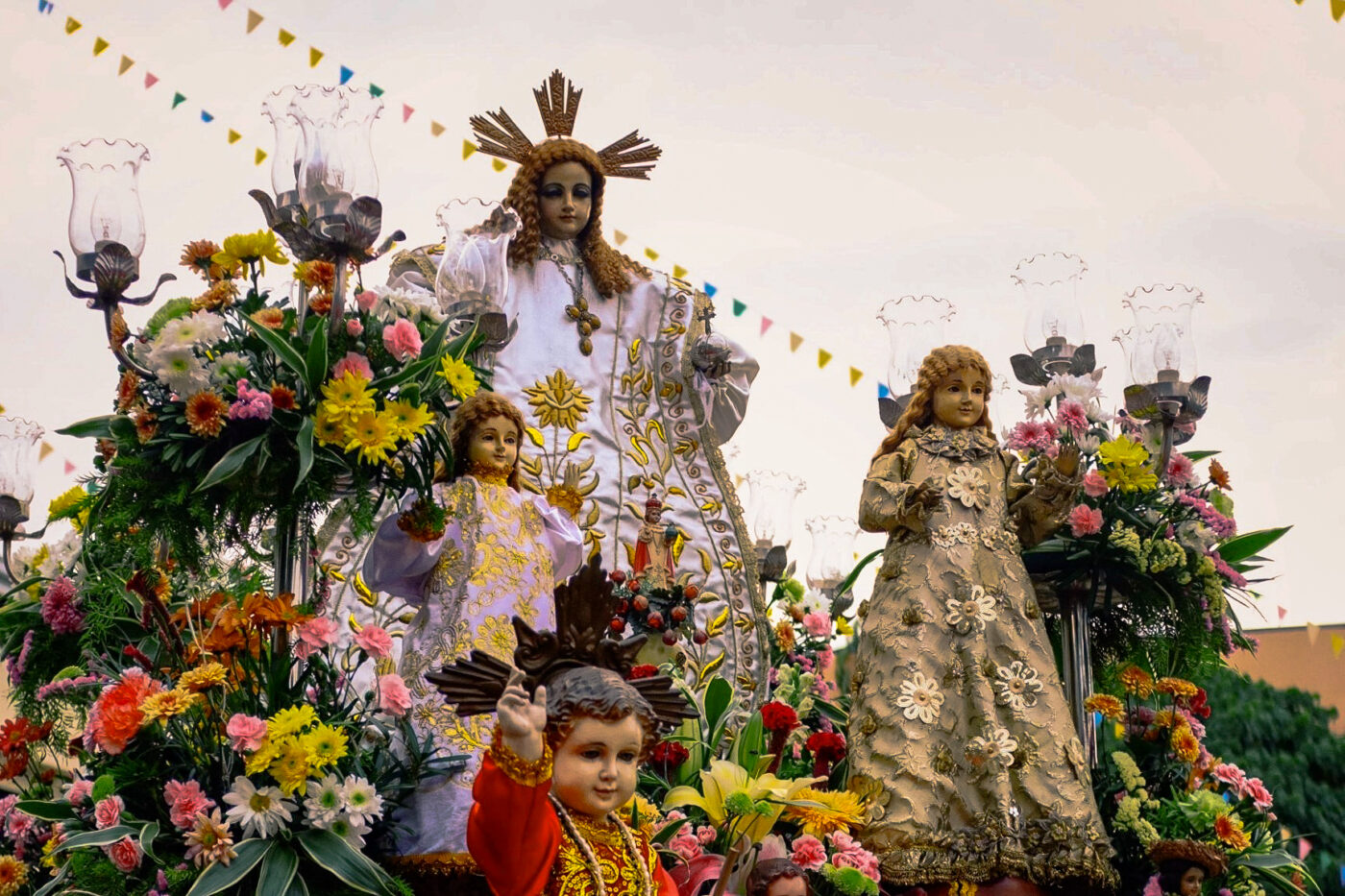Amid the grand displays of biblical images during Holy Week processions, two carozza owners ground themselves on the true essence of Lent—paving the way for faith and love to flourish.
DURING HOLY Week, the streets come alive.
In Barangay Sta. Elena, Marikina City, the normally bustling marketplace town slows down before dusk. People come out in droves to anticipate the local procession beneath the sun. A strong silence wails through the street, signaling the arrival of the carozzas. Solemnity fills the air as devotees and passersby alike gaze up at the intricately sculpted saints in their finery.
Meanwhile, in Baliwag City, Province of Bulacan, a buzz of anticipation surrounds the plaza of Saint Augustine Parish Church. The carozzas are lined up, ready for the six-hour procession that awaits. Large crowds stand by with candles in hand and excitement in their eyes.
The season of Lent is customarily viewed as a time of reflection and abstinence. But for Catholic Filipinos, the religious tradition often comes with grandeur. Wherever they are in the country, the festivities—marked by colorful swaths of fabric, beaded silks, and thoughtful floral arrangements—invite devotees to reevaluate such expressions of faith.
Communal commitment
In Marikina City, the procession of Our Lady of the Abandoned Parish (OLA) boasts over 80 carozzas, some of which have been participating for decades. One image is the Scourging at the Pillar, which first joined the procession in 1983. This image is under the care of Allan Perez and his siblings, whose late parents decided to acquire the image in 198o.
For this family, getting the carozza ready is a practiced art honed by their decades of experience. Those who are new to owning a carozza may start preparing days before the procession, but Perez and his family do so on the day of the procession itself.
Among the preparations, food takes as much precedence as the carozza. In Filipino fashion, the people who push the image and the mang-iilaw (candlelighters) who join them, are fed too.
On Holy Wednesday, preparations start between 7 AM to 8 AM, then end around 2 PM. The set-up done during this day lasts until Good Friday. By then, all that is left is to change the images’ garments and prepare food for the devotees joining them.
The experience of Perez contrasts the time-consuming preparation for the processions in Bulacan. In Baliwag, the carozza itself is given a check-up months before Holy Week. During these check-ups, its rusty edges are repainted, and the flat tires are replaced. The design also plays an important role when it comes to the clothes for the images, as these are created and ordered months before the ceremony.
Mrs. Monette Rodriguez-Salapantan has been participating in the Baliwag processions for 45 years. The Rodriguez family owns the image of Ang Pagsalubong ni Hesus sa Kanyang Ina (Jesus Meets His Afflicted Mother). Their carozza is one out of the roughly estimated 120 carozzas that parade around Baliwag on the evening of Holy Wednesday and Good Friday.
As the eldest child, Salapantan takes it upon herself to manage all the necessary preparations despite residing in Quezon City. Before she heads to Baliwag, she makes sure to contact those in charge of the necessary materials and repairs to ensure that everything is set for the procession. By Holy Monday, the carozza and manpower are ready for the journey.
On Holy Wednesday and Good Friday, Salapantan leaves Quezon City after lunch, arrives in Baliwag a few hours before the procession begins, and heads to the church where their family’s carozza is stationed. With candles at hand, they take on the entire six-hour procession until midnight.
Faith that moves
For Perez, maintaining their carozza is a bonding experience. He sees this 40-year tradition as an opportunity to honor his parents and to spend time with family. His children and nephews are also already involved with simple tasks for preparation.
At the same time, part of their mission is to tell the story of Christ. “Actually, we’re quite motivated when it comes to the procession because we’re being part of that storytelling, especially to those who [don’t] know Christ,” he shares in a mix of English and Filipino.
Likewise, Salapantan sees the procession as an opportunity to retell the story of the passion, death, and resurrection of Jesus to the younger generation. As a parent, her goal was to teach her children about how processions are done, because there will come a time when her children, nieces, and nephews become the ones to take charge.
At an early age, her children would be assigned to minor roles like helping out with the flowers and distributing food. She believes that when taught early, the tradition starts to become a way of life rather than a struggle to get through.
When Salapantan was younger, her mother was the pillar she looked up to. “My mom has lifted everything up to Him. Everything depends on Him, so her faith has really moved me. I was not surprised, even a bit, when she wanted to have a carozza,” she expresses.
Thus, being surrounded by a religious family deepened her relationship with her faith—much like many families in Baliwag, she says. Every carozza that is passed down comes with the family’s faith and tradition embedded in it. Now, she walks with the procession without a bit of overwhelming exhaustion, steadfast in her belief that the Holy Week experience is incomplete without it.
To enlighten
As they parade their respective carozzas into the night, Perez and Salapantan have a shared sentiment: Less is more in light of this performance art.
“Masyadong bongga, masyadong extravagant, to the point na hindi na natin nakukuwento nang tama ‘yung istorya, kasi sasabihin ng tao, ‘Ay, ang ganda ng bulaklak, ang ganda ng damit.’ Hindi na nakikita ngayon ‘yung sakripisyo ni Kristo, ‘di ba?” Perez ponders.
(If it’s too extravagant, to the point that the storytelling is being told inaccurately,people will only say, ‘Oh, the flowers and clothes are beautiful.’ What about Christ’s sacrifice?)
Apart from maintaining the carozza, Perez used to participate in choir and help fix the altar, but he still feels that these were not enough. However, as he ages, he acknowledges that there comes a time to let the younger generations shine.
In a similar vein, Salapantan recalls that Holy Week processions in Bulacan used to be more extravagant when she was a child. Carozza owners would wear gowns and designer clothes as they walked the six-hour procession, and the carozza itself would have flashy features like moving statues. However, the current parish agreed to restrict these kinds of showmanship to make the event more centered around prayer, solemnity, and faith.
Upon reflection, processions become more than just images parading around a city. For Perez and Salapantan, the event is more about the story of Christ and the families who pour their hearts into their faith.
However, when the long walk is over and the carozzas are parked, the work does not stop. Instead of becoming a culmination of devotion, these processions can turn into stepping stones that pave the way for faith and love to flourish.







